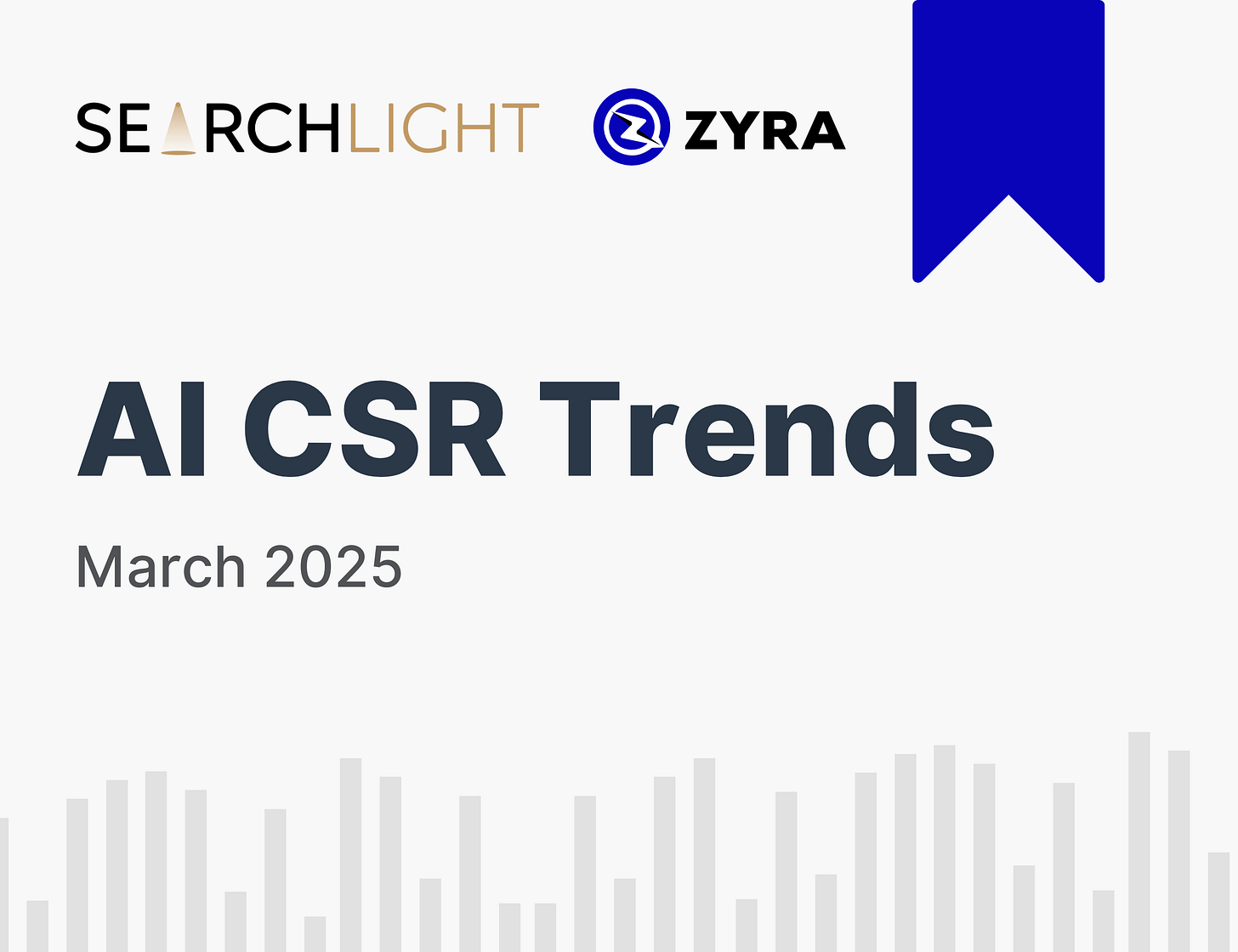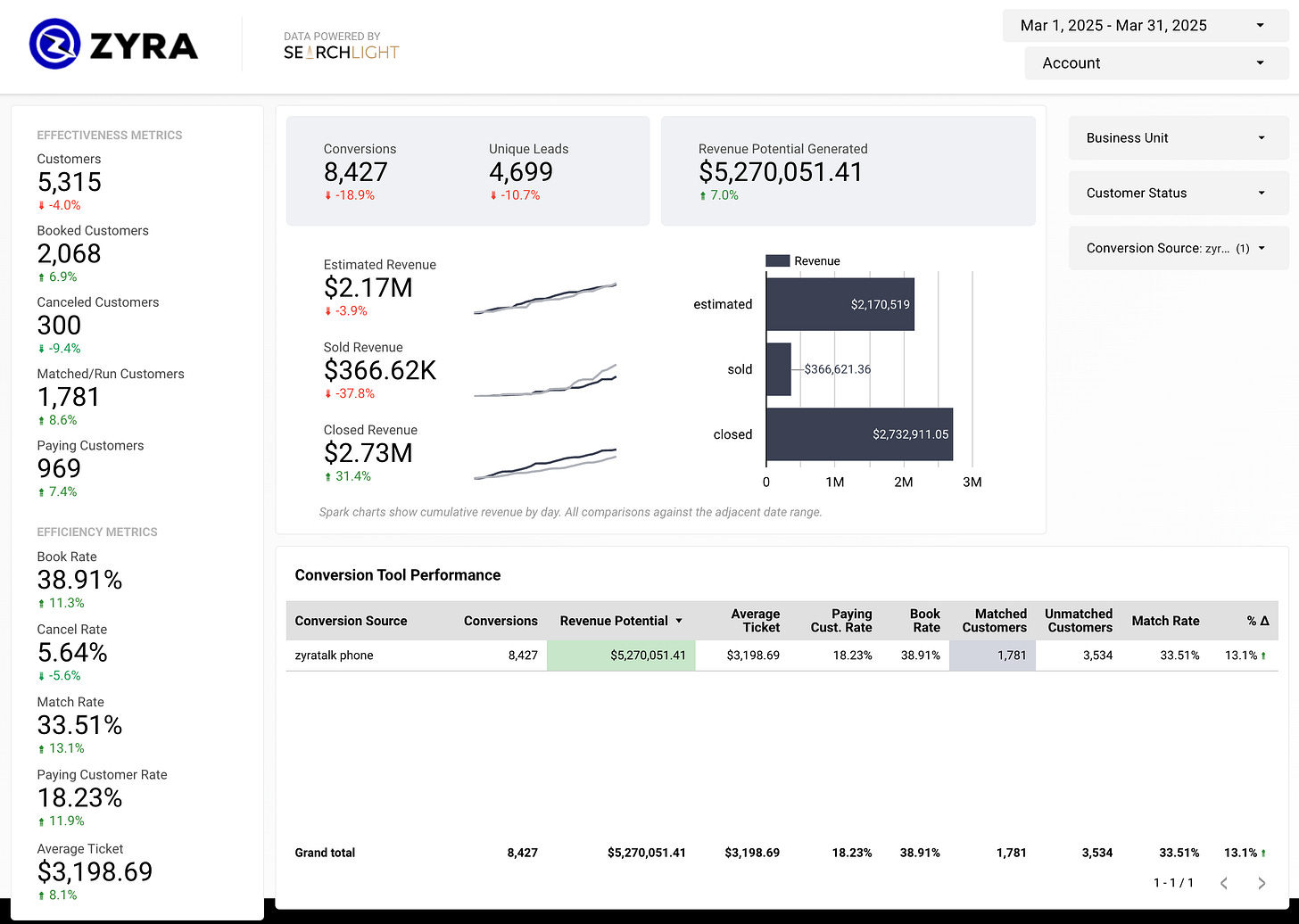AI CSR Trends
ZyraTalk Data
👋 Hey, Jon here! This week, we’re diving into ZyraTalk’s AI CSR performance for the month of March with benchmarks and comparisons to human CSR performance and a Q1 recap.
Note: We had some great questions come up the first time we published this data, so I wanted to call out a few things to keep in mind:
(1) The booking rates listed are a raw booking rate—the calculation is done using all unique leads (60 seconds or more for calls). We aren’t throwing leads away in this case, even if they’re marked as “non-lead.” The idea is, if you get 100 calls answered by an AI or human CSR, how many are you booking?
(2) We aren’t currently differentiating after-hours calls from business-hour calls—it’s reasonable to speculate on lead quality differences, but that is not controlled for in this data.
Below is a recap of January 26th through February 26th AI CSR performance:
Unique Lead Volume: 5,003 unique leads handled by AI CSRs
Raw Booking Rate: 36% (percentage of all unique leads that turned into a booked customer)
Run Rate: 28% (percentage of all unique leads that turned into a run job)
Paying Customer Rate: 16% (percentage of all unique leads that turned into a paying customer)
Closed Revenue: $1.86 million (35% of total closed revenue handling 46% of unique lead volume)
The data below for March 2025 is from 23 businesses across the US utilizing Zyratalk AI CSRs.
AI CSRs Drove a 39% Raw Book Rate Across 4,699 Unique Leads
Out of 4,699 unique leads, ZyraTalk’s AI CSRs converted 39% of those to booked appointments, compared to 36% from human CSRs.
In this same time frame, human CSRs handled nearly 4,443 leads. This is the first month we’ve seen AI CSRs handle more unique leads than human CSRs in this sample.
Last month, human CSRs handled 54% of the lead volume, while AI CSRs handled 46%, but this month, it’s a 51% (AI CSR) to 49% (human CSR) split.
Keep in mind, the 39% referenced above is a “raw booking rate” - no calls are thrown out. There are no “not leads” or “excused/abandoned calls.” Out of 100 unique leads, 39 booked.
Zyratalk’s AI CSRs booked customers for a range of services, including plumbing and HVAC service, AC installs, electrical service, drain cleaning, plumbing installs, service contracts, and more.
Over the last few months, Zyratalk’s AI CSRs have been able to book appointments for a diverse array of services.
Of the leads booked by ZyraTalk’s AI CSRs, 25% were new customers (vs. 8% last month), compared to 32% for human CSRs.
Unique Leads Handled By AI CSRs Had A 33% Run Rate
About 6% of the unique leads booked by ZyraTalk’s AI CSRs canceled their appointments, compared to about 4% from human CSRs.
In past months, cancel rates between AI and human CSRs were largely the same, but in the first month that we saw AI CSRs surpass lead handling volume, we also saw a slight uptick in cancellations compared to human CSRs. This may be irrelevant to the CSR who handled the call, but it is worth noting.
The initial key metric we care about with CSRs is the book rate, but we do want to see how those leads fare as they get further down the funnel.
Over the last few months, we haven’t seen any notable drop-offs in KPIs further down the customer journey funnel. This month’s run rate was 33% from leads booked via AI CSRs (33% for human CSRs as well).
24% of jobs run from ZyraTalk’s AI CSR bookings were from new customers, compared to 31% from human CSRs.
Unique Leads Handled By AI CSRs Had An 18% Paying Customer Rate
18% of the total unique leads handled by ZyraTalk’s CSRs turned into paying customers with an average ticket of $3,198.69 (up from $2,964.05 last month).
24% of paying customers were new and spent an average of $3,450.57 (down from $3,732.77 last month).
The paying customer rate of unique leads booked by human CSRs was 2% lower, coming in at 16%, but those paying customers had a higher average ticket of $4,427.02.
Of those paying customers, 32% were new and spent an average of $4,934.22.
Paying customer rates rely more on the in-home sales process than CSRs. Still, following the customer journey from the initial sale to revenue is essential when analyzing the tools you use to improve your business.
Let’s take a look at the revenue generation comparison between ZyraTalk CSRs and human CSRs 👇
Unique Leads Handled By AI CSRs Generated $2.73 Million of Closed Revenue
Out of the total lead volume in this data sample, ZyraTalk’s AI CSRs handled 51% of that volume, generating $2.73 million in closed revenue, or 50% of the total closed revenue from all calls in March (up from 35% last month).
Unique leads booked by ZyraTalk’s AI CSRs also generated $5.27 million in revenue opportunity (estimated revenue + sold revenue + closed revenue), or 46% of the total revenue opportunity generated from all calls in March.
59% of the AI CSR revenue opportunity was converted to sold/closed revenue, compared to 55% of the human-generated revenue opportunity.
In comparison, the human CSRs, handling 49% of the lead volume, generated 50% of closed revenue for the businesses in this sample.
Although book rates were higher for AI CSRs, those customers canceled appointments at a slightly higher rate and spent less on average than customers booked via human CSRs.
However, the unique lead volume was mostly evenly split between human and AI CSRs, and the resulting closed revenue was also evenly split.
Of the closed revenue ZyraTalk’s AI CSRs generated, 24% came from new customers, compared to 34% from human CSRs.
Q1 AI CSR and Human CSR Recap
With Q1 in the books, AI CSRs have fared well compared to human CSRs:
AI CSRs’ raw booking rate for Q1 was 36.66% vs. 38.65% for human CSRs, with a slightly lower overall cancel rate of 6.43% compared to 7.09% for humans.
AI CSRs handled 45% of phone leads for the businesses in this sample for Q1, although fewer paying customers were generated, and those paying customers spent less on average than those booked by human CSRs.
It’s not necessarily the booking experience that would drive higher average tickets or more paying customers. However, it’s still relevant to see how those booked appointments fared throughout the rest of the customer journey.
Until next time . . .
-Jon



